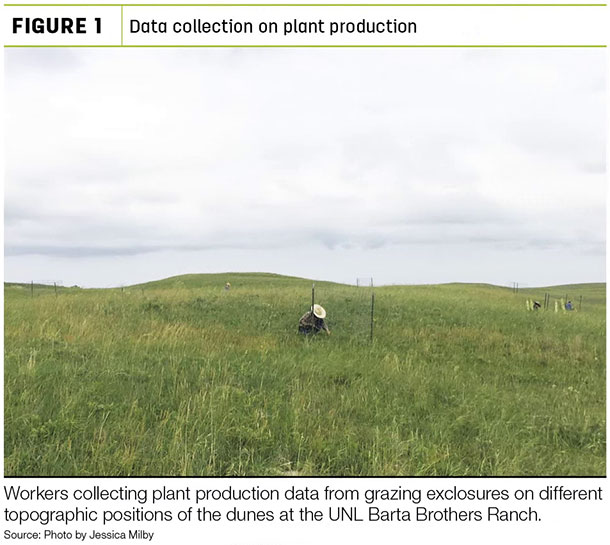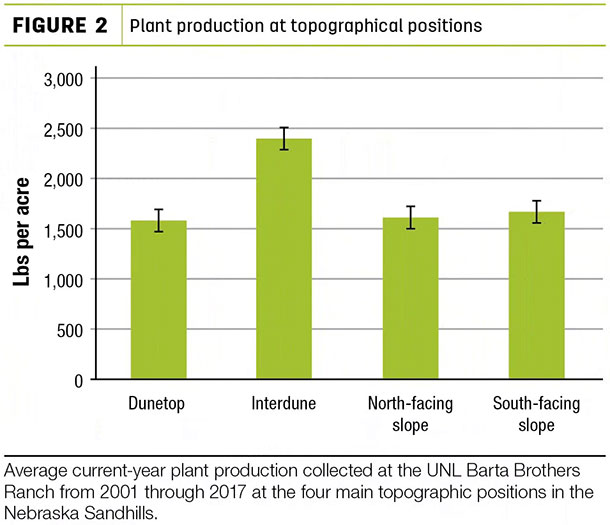Annual plant production on native rangelands is dynamic and influenced by many factors. However, the most critical determining factor for plant production in the western U.S. is the amount and timing of spring and summer precipitation, which can be highly variable from year to year. As livestock producers who are currently managing through a drought well know, precipitation is the main driver in the amount of forage available for grazing livestock.
In addition to the temporal, year-to-year variability of precipitation, many rangelands exhibit spatial variability in plant production because of differences in soil type, species composition and topographic position across a landscape.
While some rangelands are relatively uniform in their plant production, many areas are highly heterogeneous in their spatial variability, which adds another layer of complexity when considering appropriate annual stocking rates. Spatial variability within a pasture not only influences plant production but also how uniformly livestock will graze within a pasture.
The Nebraska Sandhills is a topographically diverse region of the northern Great Plains characterized by grass-covered sand dunes with dry interdune valleys between the dunes. The dry interdune valleys are typically intermixed with the slopes and dunetops of the sand dunes.
A long-term research project was developed at the University of Nebraska – Lincoln Barta Brothers Ranch in the eastern Sandhills near Rose, Nebraska, to better understand the spatial variability of plant production and how plant production responds to variable precipitation among the different topographic positions.
Plant production data were collected at four topographic positions – interdune valleys, north-facing slopes, south-facing slopes and dunetops – from grazing exclosures moved annually to account for the grazing on the pastures (Figure 1).

Over the 17 years of the study (2001 through 2017), average plant production was approximately 1,800 pounds per acre, but there was a nearly threefold difference between the years with the lowest and highest plant production.
When averaged across the topographic positions, the lowest plant production was in 2002 (884 pounds per acre), and the highest plant production was in 2009 (2,613 pounds per acre). The large differences in plant production between these years demonstrates the potential scale of temporal variability in plant production in this environment based on dry and wet years.
When analyzing the spatial variability in plant production at the different topographic positions, average plant production was 48 percent greater on interdune valleys compared to the slope and dunetop positions (Figure 2).
 Additionally, production on interdune valleys was more sensitive to increasing precipitation and had a greater positive response to years with increased spring precipitation than the slope and dune topographic positions.
Additionally, production on interdune valleys was more sensitive to increasing precipitation and had a greater positive response to years with increased spring precipitation than the slope and dune topographic positions.
For example, plant production was only 23 percent greater on interdune valleys than the slopes and dunetops in years with the driest springs but 70 percent greater during years with the wettest springs from 2001 through 2017.
The spatial differences in plant production among the topographic positions highlight the importance of considering spatial variability in estimating forage production on rangelands.
The greater increase in plant production on interdunes in the Sandhills likely resulted from greater soil moisture early in the growing season on interdunes compared to dunetops and slopes. Differences in species composition between the dune and interdune positions also contributed to the differences in plant production.
The interdune positions were dominated by the introduced cool-season grass Kentucky bluegrass and the warm-season season tallgrass switchgrass. The slopes and dunetops were primarily comprised of the cool-season native grass needle and thread and warm-season tallgrasses.
Kentucky bluegrass is highly responsive to early season precipitation and increased soil moisture, and appeared to strongly influence the greater total plant production on interdunes compared to dunes, especially during wet years.
While variability in plant production as a result of temporal weather patterns and spatial differences across a landscape typically cannot be controlled, the management response to these variable conditions is one of the grazing manager’s most important decisions.
Overall, the goal of adaptive grazing management is to sustainably match forage demand from grazing animals with the available forage supply. This is difficult in arid and semi-arid environments, where there can be large annual differences in forage production.
Additionally, spatially diverse landscapes like the Sandhills can influence plant production based on the topographic position of the landscape.
Adaptive management of rangelands with variable forage production requires a high level of planning, monitoring of precipitation and vegetation, frequent observations of pastures to appropriately adjust grazing management with changing growing season conditions and, maybe most importantly, flexibility in stocking rates to limit overgrazing on desirable grass species. ![]()

-
Mitchell Stephenson
- Extension Specialist
- University of Nebraska – Lincoln








